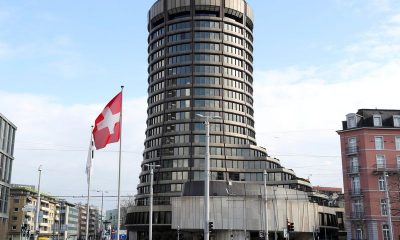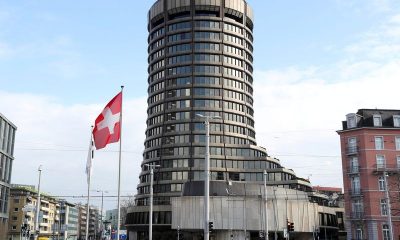Economy
ECB to raise rates further even as economy stutters

The European Central Bank is all but certain to raise borrowing costs to their highest level in 22 years on Thursday and leave the door open to more hikes, extending its fight against high inflation even as the euro zone economy flags.
Growth across the 20 countries that share the euro is at best stagnating and inflation has been moderating for months, courtesy of lower energy prices and the steepest increase in interest rates in the ECB’s 25-year history.
Furthermore, the U.S. Federal Reserve broke a string of 10 successive rate hikes late on Wednesday, a powerful signal for investors around the world that the current tightening cycle across developed economies is nearing an end, even if more U.S. rate hikes are still possible.
But inflation in the euro zone is still unacceptably high for the ECB at 6.1% – more than three times its 2% target – and underlying price growth, which typically excludes food and energy, is only starting to slow.
That is likely to keep the ECB on the tightening path, particularly after it failed to predict the current bout of high inflation and began raising rates later than many global peers last year.
“They simply cannot afford to mess it up once again,” said Carsten Brzeski, the global head of macro at Dutch bank ING.
The ECB is predicted to increase the deposit rate – the interest rate banks pay to park cash securely at the central bank – for the eighth consecutive time, by 25 basis points to 3.5%, its highest level since 2001.
Economists polled by Reuters expect another move of the same magnitude in July, a move a host of policymakers have already flagged, possibly to put pressure on colleagues going into Thursday’s meeting.
While moves beyond July are less certain, ECB President Christine Lagarde is expected to keep a further hike in September in play and to push back against investor bets that the central bank will cut rates early next year.
“The bigger question is about the forward guidance,” JPMorgan economist Greg Fuzesi said. “We are not convinced that the statement will signal or suggest that a July hike may be the last.”
The Fed’s pause was expected to temper ECB rate hike bets but investors actually pushed up their rate expectations overnight and now see the deposit rate peaking at 3.85%, suggesting that one more rate move after July is increasingly likely.
MIXED PICTURE
The ECB will update its economic forecasts, which are likely to put inflation closer to, but still above, 2% next year before it reaches the target in 2025.
While this would normally augur a pause in policy tightening, the ECB has been taking its own projections with a pinch of salt after years in which they missed the mark.
Instead, euro zone rate-setters have focused on actual economic data that have been painting a mixed picture.
Two quarters of contraction in industrial powerhouse Germany dragged the euro zone into a shallow recession last winter and the economy is likely to eke out only modest growth this year.
But unemployment is at record lows and wage growth is picking up, even if it still lags inflation.
Headline price growth has been falling fast after hitting double-digits late last year. But underlying prices, most notably for services, have yet to show the decisive drop ECB policymakers have said they would need to see before taking their foot off the monetary brake.
Higher borrowing costs are curbing demand for credit from households and companies as well as banks’ willingness to lend, but consumption is holding up well in nominal terms.
These opposing factors were likely to provide ammunition to both sides of the ECB’s Governing Council – the hawkish majority that has been pushing for more rate hikes and a minority of doves who have been advocating a pause.
As a result, economists expect the ECB to send out a more balanced message about the outlook than at recent meetings, when it stressed the need to raise rates further to cool demand.
“The ECB will probably emphasise even more strongly than before that its future policy path is data-dependent amid heightened uncertainty,” economists at Berenberg wrote in a note to clients.
Economy
Russian central bank says it needs months to make sure CPI falling before rate cuts -RBC


© Reuters. Russian Central Bank Governor Elvira Nabiullina attends a news conference in Moscow, Russia June 14, 2019. REUTERS/Shamil Zhumatov/File Photo
MOSCOW (Reuters) – Russia’s central bank will need two to three months to make sure that inflation is steadily declining before taking any decision on interest rate cuts, the bank’s governor Elvira Nabiullina told RBC media on Sunday.
The central bank raised its key interest rate by 100 basis points to 16% earlier in December, hiking for the fifth consecutive meeting in response to stubborn inflation, and suggested that its tightening cycle was nearly over.
Nabiullina said it was not yet clear when exactly the regulator would start cutting rates, however.
“We really need to make sure that inflation is steadily decreasing, that these are not one-off factors that can affect the rate of price growth in a particular month,” she said.
Nabiullina said the bank was taking into account a wide range of indicators but primarily those that “characterize the stability of inflation”.
“This will take two or three months or more – it depends on how much the wide range of indicators that characterize sustainable inflation declines,” she said.
The bank will next convene to set its benchmark rate on Feb. 16.
The governor also said the bank should have started monetary policy tightening earlier than in July, when it embarked on the rate-hiking cycle.
Economy
China identifies second set of projects in $140 billion spending plan


© Reuters. FILE PHOTO: Workers walk past an under-construction area with completed office towers in the background, in Shenzhen’s Qianhai new district, Guangdong province, China August 25, 2023. REUTERS/David Kirton/File Photo
SHANGHAI (Reuters) – China’s top planning body said on Saturday it had identified a second batch of public investment projects, including flood control and disaster relief programmes, under a bond issuance and investment plan announced in October to boost the economy.
With the latest tranche, China has now earmarked more than 800 billion yuan of its 1 trillion yuan ($140 billion) in additional government bond issuance in the fourth quarter, as it focuses on fiscal steps to shore up the flagging economy.
The National Development and Reform Commission (NDRC) said in a statement on Saturday it had identified 9,600 projects with planned investment of more than 560 billion yuan.
China’s economy, the world’s second largest, is struggling to regain its footing post-COVID-19 as policymakers grapple with tepid consumer demand, weak exports, falling foreign investment and a deepening real estate crisis.
The 1 trillion yuan in additional bond issuance will widen China’s 2023 budget deficit ratio to around 3.8 percent from 3 percent, the state-run Xinhua news agency has said.
“Construction of the projects will improve China’s flood control system, emergency response mechanism and disaster relief capabilities, and better protect people’s lives and property, so it is very significant,” the NDRC said.
The agency said it will coordinate with other government bodies to make sure that funds are allocated speedily for investment and that high standards of quality are maintained in project construction.
($1 = 7.1315 renminbi)
Economy
Russian central bank says it needs months to make sure CPI falling before rate cuts -RBC


© Reuters. Russian Central Bank Governor Elvira Nabiullina attends a news conference in Moscow, Russia June 14, 2019. REUTERS/Shamil Zhumatov/File Photo
MOSCOW (Reuters) – Russia’s central bank will need two to three months to make sure that inflation is steadily declining before taking any decision on interest rate cuts, the bank’s governor Elvira Nabiullina told RBC media on Sunday.
The central bank raised its key interest rate by 100 basis points to 16% earlier in December, hiking for the fifth consecutive meeting in response to stubborn inflation, and suggested that its tightening cycle was nearly over.
Nabiullina said it was not yet clear when exactly the regulator would start cutting rates, however.
“We really need to make sure that inflation is steadily decreasing, that these are not one-off factors that can affect the rate of price growth in a particular month,” she said.
Nabiullina said the bank was taking into account a wide range of indicators but primarily those that “characterize the stability of inflation”.
“This will take two or three months or more – it depends on how much the wide range of indicators that characterize sustainable inflation declines,” she said.
The bank will next convene to set its benchmark rate on Feb. 16.
The governor also said the bank should have started monetary policy tightening earlier than in July, when it embarked on the rate-hiking cycle.

 Forex3 years ago
Forex3 years agoForex Today: the dollar is gaining strength amid gloomy sentiment at the start of the Fed’s week

 Forex3 years ago
Forex3 years agoUnbiased review of Pocket Option broker

 Forex3 years ago
Forex3 years agoDollar to pound sterling exchange rate today: Pound plummeted to its lowest since 1985

 Forex3 years ago
Forex3 years agoHow is the Australian dollar doing today?

 Cryptocurrency3 years ago
Cryptocurrency3 years agoWhat happened in the crypto market – current events today

 World3 years ago
World3 years agoWhy are modern video games an art form?

 Commodities3 years ago
Commodities3 years agoCopper continues to fall in price on expectations of lower demand in China

 Economy3 years ago
Economy3 years agoCrude oil tankers double in price due to EU anti-Russian sanctions



























